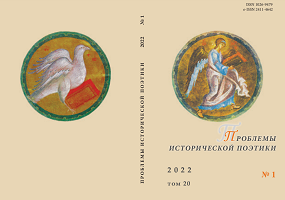Библейская интертекстуальность эпиграфа к роману Ф. М. Достоевского «Братья Карамазовы»
The Biblical Intertextuality of the Epigraph to F. M. Dostoevsky’s Novel “The Brothers Karamazov”
Author(s): Katalin KroóSubject(s): Christian Theology and Religion, Metaphysics, Russian Literature, Biblical studies
Published by: Петрозаводский государственный университет
Keywords: Dostoevsky; The Brothers Karamazov; epigraph; biblical intertextuality; Old and New Testament parallelisms; The Gospel of John; The Book of Isaiah; temporal ontologization of the word; chronotope;
Summary/Abstract: The problem of biblical citation posed in this article relates to a wellknown field of research in Dostoevsky studies, in which there are outstanding achievements. A peculiar approach to the proposed topic is offered within the framework of this paper. The subject of the study is the epigraph to the novel “The Brothers Karamazov”. The first special feature of the interpretation of its biblical intertextuality is connected with the clarification of the multidimensional function of Dostoevsky’s introduction to the said novel. The three key “hermeneutic” motifs of “The Grand Inquisitor”, namely, Mistery, Miracle and Authority, are revealed in the author’s preface. They allow to see the complexity of the “prophecy,” a premonition that concerns the future of the novel, its main character and the reader’s reception. The semanticization of time within the limits of “pre-” and “post-” determines the interpretation of the biblical intertextuality of the epigraph, the idea of which in its first discursive appearance is integrated with the author’s preface, rather than with the novel in its entirety. The “pre-word” and “post-word” in the epigraph also act as metatextual motifs, due to the fact that not only certain passages from the New Testament are parallelized in the biblical intertextual space, but they are also linked to the Old Testament. The second characteristic feature of understanding the epigraph’s biblical citation is the unification of different components of the created intertextual space. The main object of study is the motif of word; a wide range of its semantics is examined, i.e., in the context of adoring praise and glorification, in the light of successive mutual transformations of auditory and visual elements of communication, perception of the world and shifts of subjects, in the perspective of the chronotopic systematicity of prophecy, in the projection of the word on the time axis as the first and repeated word (in the “pre” and “post” positions). The aspects of initiation, mediation and continuation of the word, as well as the problem of changing the status of primacy and secondariness, are emphasized in the interpretation of time. As a result, the biblical intertextuality in the epigraph, together with the author’s preface, lead to the ontologization of time both in the personal plot (a person’s inner growth) and in the metaphysical (faith-related) meaning, and, not least, in Dostoevsky’s conceptualization of textual self-reflexivity in the Bible.
Journal: Проблемы исторической поэтики
- Issue Year: 20/2022
- Issue No: 1
- Page Range: 208-234
- Page Count: 27
- Language: Russian

